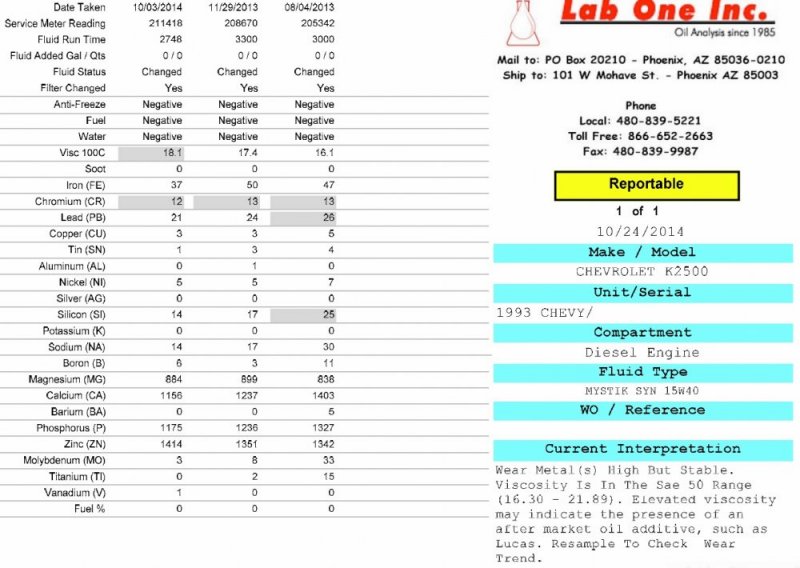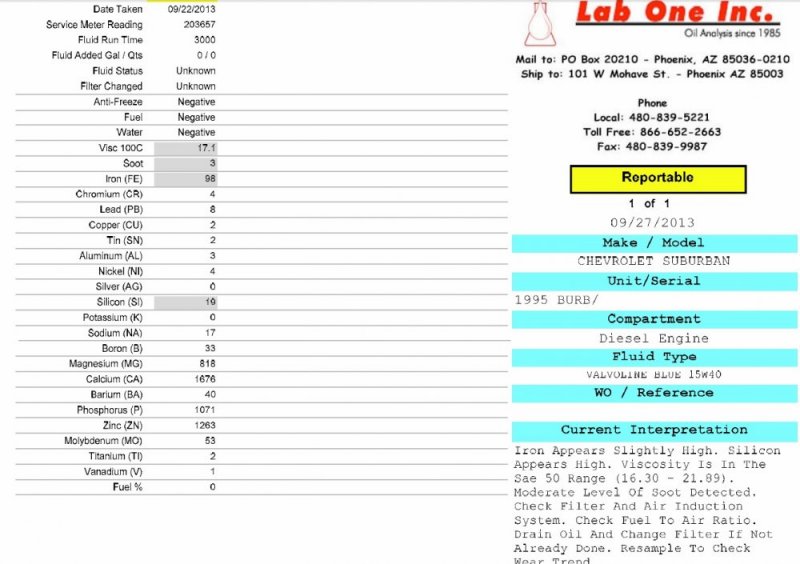Hink
Overkill Is Underrated
Hi all,
Just an FYI and I'm putting it in the performance section since the report is on an engine with a few mods...
I got my first ever oil report back from Blackstone Labs. The engine is a recently rebuilt Optimizor out of a military Hummer from Teds Trucks. One of my main concerns other than possible catastrophic rebuild quality due to an unknown rebuilder and general idea of wear was the install of ARP headstuds and getting them sealed.
I have no indication of any leaking so far (after one year), such as oil in the coolant or foam in the CDR valve so I felt pretty good, but still wanted to see it in the report.
They did say that they found a bit of an indication but it was so minute that it could be from something else or was so light that i'm not going to worry about it (after all, we're talking parts-per-million here) but I'll keep an eye on it.
So that's good news, really and the other good news is that there is only regular wear signs, so the rebuild must have been a quality job as far as bearing install, etc. But the really cool thing was the very low insoluble count and high flashpoint. Which means that there is very,very little soot and no fuel in the oil so the rings are sealing very well. I'd really like to see a comparison with Total Seal rings (and who knows, it could have been rebuilt with Total Seal rings for all I know).
The only odd thing is that the oil was a lot thicker than it should have been. Total mystery to me on that one so if anyone has some experience with that, chime in.
I attached the report and would love any advice or info from people in the know on these things!
https://dl.dropboxusercontent.com/u/4105390/The truck stop pics/93 GMC-020116.pdf
Just an FYI and I'm putting it in the performance section since the report is on an engine with a few mods...
I got my first ever oil report back from Blackstone Labs. The engine is a recently rebuilt Optimizor out of a military Hummer from Teds Trucks. One of my main concerns other than possible catastrophic rebuild quality due to an unknown rebuilder and general idea of wear was the install of ARP headstuds and getting them sealed.
I have no indication of any leaking so far (after one year), such as oil in the coolant or foam in the CDR valve so I felt pretty good, but still wanted to see it in the report.
They did say that they found a bit of an indication but it was so minute that it could be from something else or was so light that i'm not going to worry about it (after all, we're talking parts-per-million here) but I'll keep an eye on it.
So that's good news, really and the other good news is that there is only regular wear signs, so the rebuild must have been a quality job as far as bearing install, etc. But the really cool thing was the very low insoluble count and high flashpoint. Which means that there is very,very little soot and no fuel in the oil so the rings are sealing very well. I'd really like to see a comparison with Total Seal rings (and who knows, it could have been rebuilt with Total Seal rings for all I know).
The only odd thing is that the oil was a lot thicker than it should have been. Total mystery to me on that one so if anyone has some experience with that, chime in.
I attached the report and would love any advice or info from people in the know on these things!
https://dl.dropboxusercontent.com/u/4105390/The truck stop pics/93 GMC-020116.pdf
Last edited:


